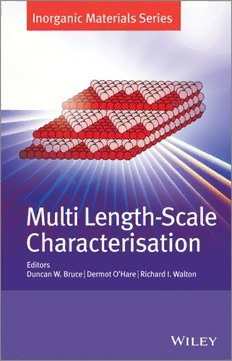Table Of ContentMulti Length-Scale
Characterisation
InorganicMaterialsSeries
SeriesEditors:
ProfessorDuncanW.Bruce
DepartmentofChemistry,UniversityofYork,UK
ProfessorDermotO'Hare
ChemistryResearchLaboratory,UniversityofOxford,UK
ProfessorRichardI.Walton
DepartmentofChemistry,UniversityofWarwick,UK
SeriesTitles
FunctionalOxides
MolecularMaterials
PorousMaterials
Low-DimensionalSolids
EnergyMaterials
LocalStructuralCharacterisation
MultiLength-ScaleCharacterisation
ForthcomingTitle
StructurefromDiffractionMethods
Multi Length-Scale
Characterisation
Edited by
Duncan W. Bruce
University of York, UK
Dermot O'Hare
University of Oxford, UK
Richard I. Walton
University of Warwick, UK
Thiseditionfirstpublished2014
©2014JohnWiley&Sons,Ltd
Registeredoffice
JohnWiley&SonsLtd,TheAtrium,SouthernGate,Chichester,WestSussex,PO198SQ,United
Kingdom
Fordetailsofourglobaleditorialoffices,forcustomerservicesandforinformationabouthowto
applyforpermissiontoreusethecopyrightmaterialinthisbookpleaseseeourwebsiteat
www.wiley.com.
Therightoftheauthortobeidentifiedastheauthorofthisworkhasbeenassertedinaccordance
withtheCopyright,DesignsandPatentsAct1988.
Allrightsreserved.Nopartofthispublicationmaybereproduced,storedinaretrievalsystem,or
transmitted,inanyformorbyanymeans,electronic,mechanical,photocopying,recordingor
otherwise,exceptaspermittedbytheUKCopyright,DesignsandPatentsAct1988,withoutthe
priorpermissionofthepublisher.
Wileyalsopublishesitsbooksinavarietyofelectronicformats.Somecontentthatappearsinprint
maynotbeavailableinelectronicbooks.
Designationsusedbycompaniestodistinguishtheirproductsareoftenclaimedastrademarks.All
brandnamesandproductnamesusedinthisbookaretradenames,servicemarks,trademarksor
registeredtrademarksoftheirrespectiveowners.Thepublisherisnotassociatedwithanyproduct
orvendormentionedinthisbook.
LimitofLiability/DisclaimerofWarranty:Whilethepublisherandauthorhaveusedtheirbest
effortsinpreparingthisbook,theymakenorepresentationsorwarrantieswithrespecttothe
accuracyorcompletenessofthecontentsofthisbookandspecificallydisclaimanyimplied
warrantiesofmerchantabilityorfitnessforaparticularpurpose.Itissoldontheunderstandingthat
thepublisherisnotengagedinrenderingprofessionalservicesandneitherthepublishernorthe
authorshallbeliablefordamagesarisingherefrom.Ifprofessionaladviceorotherexpertassistance
isrequired,theservicesofacompetentprofessionalshouldbesought.
Theadviceandstrategiescontainedhereinmaynotbesuitableforeverysituation.Inviewof
ongoingresearch,equipmentmodifications,changesingovernmentalregulations,andtheconstant
flowofinformationrelatingtotheuseofexperimentalreagents,equipment,anddevices,thereader
isurgedtoreviewandevaluatetheinformationprovidedinthepackageinsertorinstructionsfor
eachchemical,pieceofequipment,reagent,ordevicefor,amongotherthings,anychangesinthe
instructionsorindicationofusageandforaddedwarningsandprecautions.Thefactthatan
organizationorWebsiteisreferredtointhisworkasacitationand/orapotentialsourceoffurther
informationdoesnotmeanthattheauthororthepublisherendorsestheinformationthe
organizationorWebsitemayprovideorrecommendationsitmaymake.Further,readersshouldbe
awarethatInternetWebsiteslistedinthisworkmayhavechangedordisappearedbetweenwhen
thisworkwaswrittenandwhenitisread.Nowarrantymaybecreatedorextendedbyany
promotionalstatementsforthiswork.Neitherthepublishernortheauthorshallbeliableforany
damagesarisingherefrom.
LibraryofCongressCataloging-in-PublicationDataappliedfor.
AcataloguerecordforthisbookisavailablefromtheBritishLibrary.
ISBN:9781119953197
Setin10.5/13ptSabonbyLaserwordsPrivateLimited,Chennai,India
12014
Contents
InorganicMaterialsSeriesPreface xi
Preface xiii
ListofContributors xv
1 MeasurementofBulkMagneticProperties 1
ScottS.Turner
1.1 Introduction 1
1.1.1 PurposeandScope 3
1.1.2 TheOriginofMagneticProperties 4
1.1.3 TheUnitsofMagnetism 8
1.1.4 MagnetismduetoPairedElectrons 10
1.1.5 MagnetismduetoUnpairedElectrons 12
1.1.6 MagneticMaterialswithLong-RangeOrder 23
1.1.7 BriefNotesonOtherTypesofMagnetism 30
1.1.8 General Considerations for the Measurement of
MagneticProperties 33
1.2 Magnetic Measurement based on Measuring a Force or
Torque 34
1.2.1 TheGouyBalance 34
1.2.2 TheEvansBalance(orInverseGouyMethod) 36
1.2.3 TheFaradayBalance 38
1.3 MagneticMeasurementbasedonInduction 38
1.3.1 TheDCSQUIDMagnetometer 38
1.3.2 ACMagnetometry 49
1.3.3 TheMicro-(andNano-)SQUID 52
1.3.4 TheVibratingSampleMagnetometer(VSM) 52
1.4 TheEvansNMRMethod 53
1.5 BriefNotesonComplementaryTechniques 54
1.5.1 ElectronParamagneticResonance(EPR) 54
1.5.2 Ultraviolet–VisibleSpectroscopy 55
1.5.3 ThermalTechniques 56
1.5.4 MössbauerSpectroscopy 56
vi CONTENTS
1.5.5 MeasuringLocalMagneticFieldswithMuonsand
Neutrons 57
References 59
2 ThermalMethods 63
MichelB.JohnsonandMaryAnneWhite
2.1 Introduction 63
2.2 ThermalAnalysis 64
2.2.1 ThermogravimetricAnalysis 64
2.2.2 DifferentialThermalAnalysis 67
2.2.3 DifferentialScanningCalorimetry 74
2.2.4 ExampleofaCoupledThermoanalyticalTechnique 83
2.2.5 ConcludingCommentsConcerningThermal
Analysis 84
2.3 HeatCapacity 85
2.3.1 Background 85
2.3.2 AdiabaticCalorimetry 86
2.3.3 RelaxationCalorimetry 87
2.3.4 OtherHeat-CapacityMethods 90
2.3.5 EstimationofHeatCapacity 92
2.4 ThermalConductivity 95
2.4.1 Background 95
2.4.2 Steady-StateMethod 97
2.4.3 GuardedHot-PlateMethod 99
2.4.4 ParallelThermalConductanceMethod 100
2.4.5 Power-PulseMethod 102
2.4.6 Laser-FlashDiffusivity 103
2.4.7 Hot-WireMethod 105
2.4.8 3𝜔Method 106
2.5 ThermalExpansion 108
2.5.1 TerminologyandAtomicOrigins 108
2.5.2 DiffractionMethods 110
2.5.3 Dilatometry 111
2.6 Conclusion 114
References 115
3 AtomicForceMicroscopy 121
PabloCubillasandMichaelW.Anderson
3.1 Introduction 121
3.2 History 122
CONTENTS vii
3.3 TheBasicsofHowAFMWorks 123
3.3.1 InstrumentArchitecture 123
3.3.2 BasicScanningModes 127
3.3.3 CantileversandTips 133
3.3.4 ImageArtefacts 140
3.3.5 ScanningEnvironment 145
3.3.6 SamplePreparation 146
3.4 ImportantDevelopmentsinAFM 146
3.4.1 TipFunctionalisation/ChemicalForceMicroscopy 146
3.4.2 NanotubesasNanoprobes 147
3.4.3 FrequencyModulation 148
3.4.4 HigherHarmonics 149
3.4.5 AtomicResolution 150
3.4.6 HydrothermalAFM 151
3.4.7 Video-RateAFM 152
3.4.8 ActiveCantilevers 153
3.4.9 Dip-PenNanolithography 154
3.4.10 ScanningNear-FieldOpticalMicroscopy 154
3.4.11 Raman/AFM 155
3.5 SpecialisedScanningModes 156
3.5.1 PhaseImaging 156
3.5.2 Force-ModulationAFM 156
3.5.3 FrictionForceMicroscopy 157
3.5.4 ForceVolume 159
3.5.5 MagneticForceMicroscopy 159
3.5.6 ElectricForceMicroscopy 161
3.5.7 Kelvin-ProbeForceMicroscopy 162
3.5.8 PiezoresponseForceMicroscopy 162
3.5.9 Nanoindenting 163
3.6 Applications 164
3.6.1 GeneralConsiderations 164
3.6.2 Atomic-Resolution, Non-Contact AFM of Metal
Oxides 165
3.6.3 Atomic-Resolution, Frequency-Modulated AFM
inLiquids 172
3.6.4 CrystalGrowth 175
3.6.5 AtomManipulationwithAFM 180
3.6.6 DataStorage 181
3.6.7 OxideEpitaxialOvergrowths 183
3.6.8 HydrothermalAFM 184
References 185
viii CONTENTS
4 GasSorptionintheAnalysisofNanoporousSolids 195
PhilipL.Llewellyn
4.1 Introduction 195
4.2 WhatisAdsorption,WhydoFluidsAdsorbandHowCan
AdsorptionPhenomenabeVisualised? 198
4.3 AdsorptionExperiments 204
4.3.1 AdsorptionDevices 204
4.3.2 ExperimentalProtocol 205
4.4 InterpretationofIsothermstoEstimatePorousSolid
Characteristics 212
4.4.1 EvaluationofIsothermTypeandShape 212
4.4.2 Evaluation of Specific Surface Area using the BET
Model 216
4.4.3 EvaluationofExternalSurfaceAreaandPore
Volumeusingthet-or𝛼 -Method 218
S
4.4.4 EvaluationofMicroporeSize:TheHorvàth–
KawazoeMethodology 222
4.4.5 Evaluation of both Micropore and Mesopore
Size using DFT/GCMC Treatment and Isotherm
Reconstruction 224
4.5 Conclusion 227
References 229
5 DynamicLightScattering 233
ErikaEiser
5.1 Introduction 233
5.2 TheoreticalBackground 235
5.2.1 Scattering Intensities and the Autocorrelation
Function 243
5.2.2 HomodyneversusHeterodyneDetection 247
5.2.3 Relations between the Correlation Functions and
StaticLightScattering 249
5.3 Applications 250
5.3.1 ParticleSizing 250
5.3.2 IdenticalSphericalColloidsinDiluteSuspensions 251
5.3.3 ParticleSizinginRealisticSystems:Size
Distributions 253
5.3.4 DenseSystems 261
5.4 InstrumentalDevelopmentsandNewMethods 262

